
The Toshiba EMI Recordings / U.S. Edition Series
#22 The Beatles' Second Album (AP-80012)
(Update: 15th. August 2024)

 Apple 1st. Sleeve |
|
| TITLE | THE BEATLES'
SECOND ALBUM |
||||
| CATALOG NUMBER | AP-80012 |
||||
| RELEASE DATE | 25th. August 1970 / First Press |
||||
| TRACK LISTING | SIDE 1 | SIDE 2 | |||
| Roll Over Beethoven |
Long Tall Sally |
||||
| Thank You Girl |
I Call Your Name |
||||
| You Really Got A Hold On Me |
Please Mr.Postman |
||||
| Devil In The Heart |
I'll Get You (simulated stereo) |
||||
| Money (That's What I Want) |
She Loves You (simulated stereo) |
||||
| You Can't Do That (simulated stereo) |
|
||||
| FRONT --> Click! | BACK --> Click! | SIDE 1 --> Click! | SIDE 2 --> Click! | DISK | |
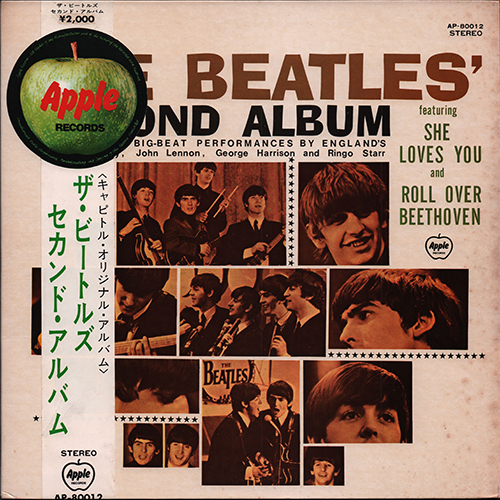 |
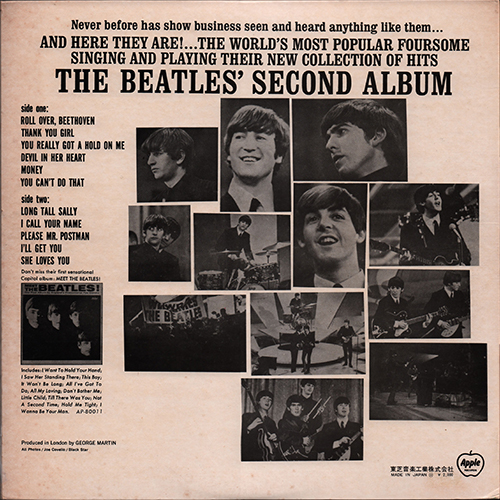 |
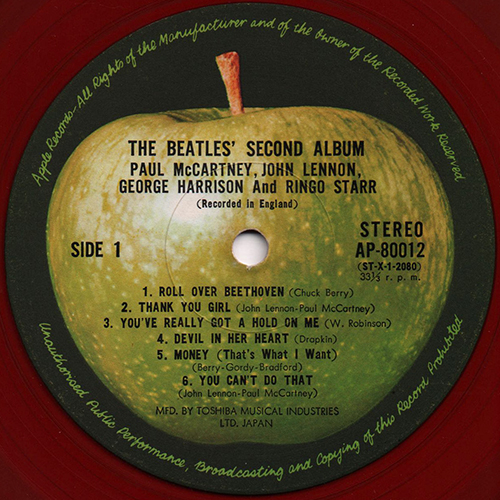 |
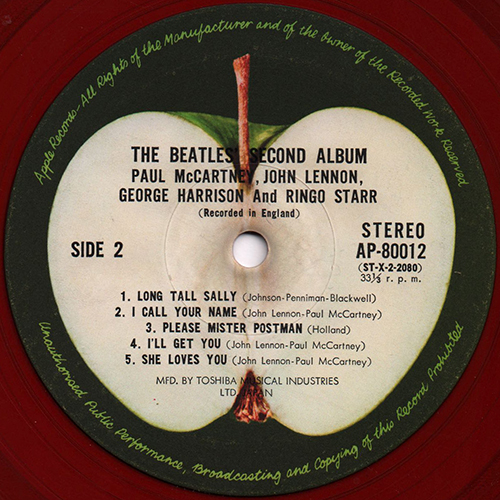 |
 |
|
| INSIDE --> Click! | INNER SLEEVE | ||||
| FRONT --> Click! | BACK --> Click! | With Apple custom black inner sleeve. | |||
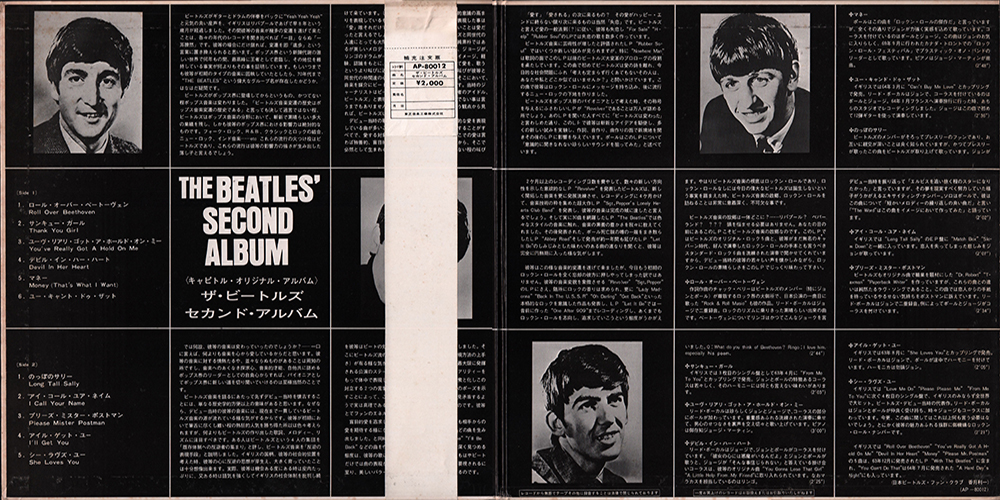 |
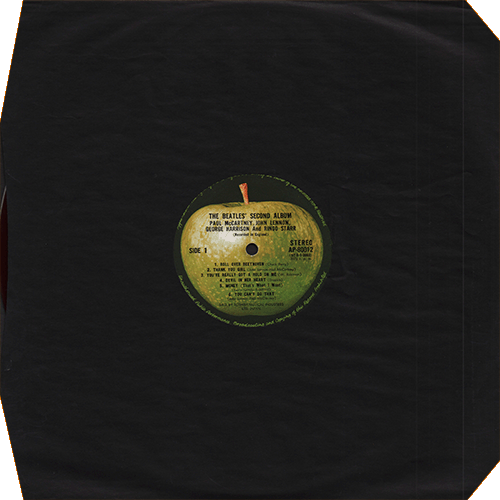 |
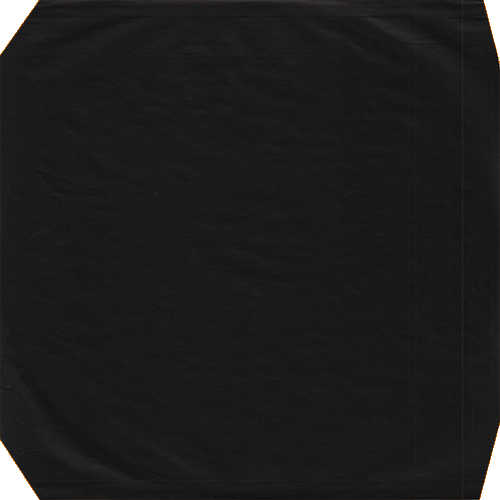 |
|||
| LYRIC SHEET (Slip
Sheet Type) |
|||||
| FRONT --> Click! | BACK --> Click! | LYRIC SHEET CLOSE UP | |||
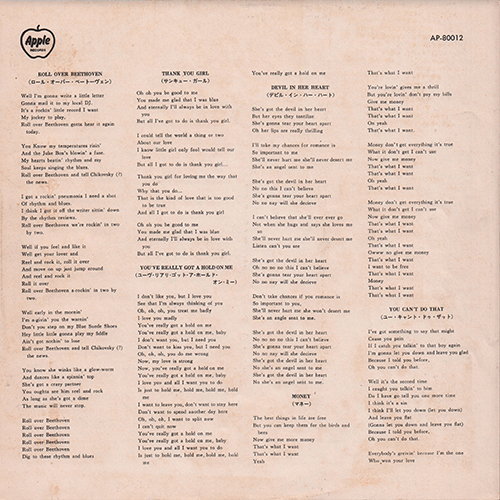 |
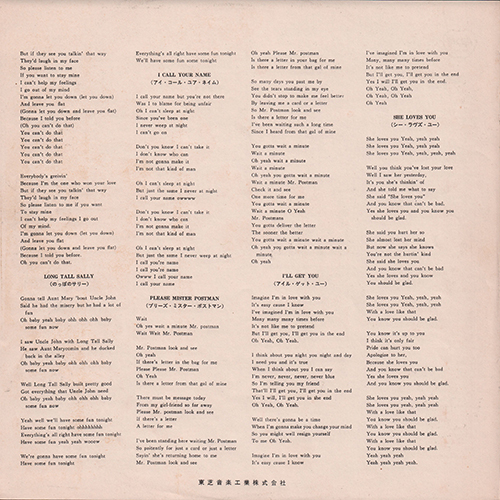 |
 |
 |
||
 |
Company name "Toshiba Musical Industries Ltd." was printed on the lyric sheet. | ||||
| FRONT AND BACK COVER CLOSE UP | |||||
 |
 |
 |
The Apple logomark was printed on the front and back
cover. "Toshiba Musical Industries Ltd." and "H ¥2,000" was printed at the bottomof the back cover. |
||
| BACK COVER CLOSE UP | |||||
 |
Produced in London by GEORGE
MARTIN All photos: Joe Covello / Black Star |
||||
| INSIDE CLOSE UP | |||||
 |
Liner notes: Toshikazu Katsuki
(1948-1999) is a leading Beatles expert in Japan. On October 21, 1976, he held his wedding ceremony at the Hilton Hotel, with Ringo Starr as a witness. |
||||
| Apple Gourd in White OBI CLOSE UP | |||||
| OBI: FRONT --> Click! | OBI: BACK --> Click! | ||||
 |
 |
 |
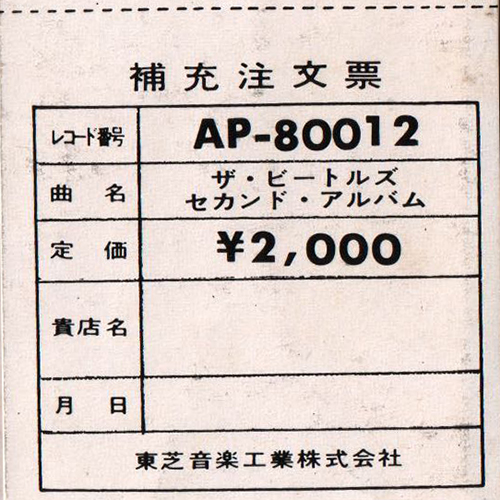 |
||
| Issued with a narrow Obi with a large round Apple logo at the top, has a white background. The word "STEREO" and Apple logo mark and catalog number "AP-80012" were printed on the front. 1st. pressing had a priced ¥2,000 on the obi strip. | Has a order sheet on the back side of the Obi. Catalog No, price "¥2,000" and "Toshiba Musical Industries Ltd."were printed at the order sheet. | ||||
| LABEL CLOSE UP | |||||
 |
 |
 |
 |
||
 |
The phrase "Apple Records -
All Rights of the Manufacturer and of the Owner of the
Recorded work Reserved." was printed at the perimeter. The words "MFD. BY TOSHIBA MUSICAL INDUSTRIES LTD. JAPAN" was printed at the bottom of the label. |
||||
| LABEL CLOSE UP | |||||
 |
 |
Dark green apple label. Slender font. |
|||
|
OTHER ITEM
|
|||||
| - | |||||
| RECORD LABEL | Dark Green Apple label Type-1 |
||||
| MIX | STEREO *excepted as noted |
||||
| MATRIX No. | SIDE 1 | ST-X-1-2080
1S2 2 |
|||
| SIDE 2 | ST-X-2-2080
1S2 5 |
||||
| PRESS MARK | 2B |
||||
| VINYL COLOR | RED |
||||
| RECORD COMPANY'S NAME | SLEEVE | Toshiba
Ongaku kogyo Kabusikigaisha |
|||
| LABEL | MFD. BY
TOSHIBA MUSICAL INDUSTRIES LTD. JAPAN |
||||
| SYMBOL/PRICE | H - ¥2,000 |
||||
| LYRIC SHEET STYLE | Slip Sheet Type |
||||
| COVER FORM | Gatefold type. Hard cover. |
||||
| INNER SLEEVE |
Apple custom black sleeve |
||||
| OBI |
"Gourd" in white Obi (a narrow Obi with a
large round Apple logo at the top) / with Order sheet |
||||
| COVER DESIGN/ PHOTO/ NOTES | All photos: Joe Covello / Black
Star |
||||
|
COMMENTS
|
Dark green Apple label
Type-1with black print. The Beatles' Second Album is the second Capitol Records album by the English rock band the Beatles. Second Album was a collection of material from various UK releases and recording sessions dating back to March 1963. Included were the five remaining tracks, all cover versions, from With the Beatles. Added to these were "Thank You Girl", the B-side to the single "From Me to You"; "She Loves You" and its B-side, "I'll Get You"; "You Can't Do That" (the B-side of "Can't Buy Me Love"), from the upcoming A Hard Day's Night UK soundtrack; and two new songs, "Long Tall Sally" and "I Call Your Name". Uses a copy of the US master, as identified by the matrix stamp. In Novemver 1968, that was the date when Apple Corp Ltd. of England and Toshiba came to an agreement on the manufacturing and distribution of the Beatles' records in Japan. As part of that agreement, Toshiba had to reissue on the Apple label all the records previously issued on the Odeon label. The sleeves also had to be altered to desplay the Apple logo. Futher still, all the Odeon catalog number prefixes were changed to ones with Apple prefixes. In most cases, only the prefixes were changed and the catalog numbers were left intanct. Odeon singles, EPs, and LPs with the OR or OP prefixes were changed to Apple singles, EPs, and LPs with the AR or AP prefixes, respectively. But Toshiba did not instantly implement all these changes and did not immediately withdraw all Odeon label records. In fact, the phasing out of the Odeon label products and the phasing in of the Apple label was a lengthy process taking several months at least. The very first record in Japan issued under the Toshiba/Apple contract and bearing the Apple label was "The Beatles double LP (the White Album)", released on 21th. January 1969. And unlike elsewhere in the world, the first single in Japan to bear the Apple label was not "Hey Jude / Revolution" but rather "Ob- La-Di, Ob-La-Da / While My Guitar Gently Weeps", released on 10th. March, 1969. And in the Apple label, there are two subtypes, TOSHIBA MUSIC and TOSHIBA EMI. Further more, the early copies of the APPLE-TOSHIBA MUSIC type have dark Apple on its label, though the late copies have light one. Red vinyl: Besides good sound and quality printing, Japanese records also offered some other things of interest to the collector. One of the primary manufacturing companies in Japan, Toshiba, pressed a lot of their records on red, “Everclean” vinyl from 1958 through 1974 (maybe). While not pressed as collectors’ items, these red vinyl pressings are more sought out by collectors than their black vinyl counterparts. The Everclean vinyl was designed to be less prone to collecting static electricity and dust than the more common black vinyl. The obi: Apple "Gourd" in white Obi 1st. pressing issued with a narrow Obi with a large round Apple logo at the top, has a white background. The word "STEREO" and Apple logo mark and catalog number "AP-80034" were printed on the front. 1st. pressing had a priced ¥2,000 on rear sleeve and obi strip. While most Japanese records feature local music, a lot of music fans there like foreign music, as well. The language barrier in Japan presented a problem – should foreign album covers be changed for Japanese albums? The solution was the obi, which means “belt” or “sash”. The obi is a strip of paper, usually about two inches wide, that wraps vertically around the album cover, containing information about the artist and album in Japanese. As these strips of paper were fragile and easily torn, they are often missing, especially since consumers in the 1950s and 1960s attached little significance to them. Finding Japanese records made prior to 1970 that still have the obi intact can be quite difficult, and for some albums, nearly impossible. The inclusion of the obi can dramatically affect the price of some Japanese records, sometimes increasing the price by a factor of ten. |
||||
| TITLE | THE BEATLES'
SECOND ALBUM |
||||
| CATALOG NUMBER | AP-80012 |
||||
| RELEASE DATE | 25th. Auguast 1970 / First Press |
||||
| TRACK LISTING | SIDE 1 | SIDE 2 | |||
| Roll Over Beethoven |
Long Tall Sally |
||||
| Thank You Girl |
I Call Your Name |
||||
| You Really Got A Hold On Me |
Please Mr.Postman |
||||
| Devil In The Heart |
I'll Get You (simulated stereo) |
||||
| Money (That's What I Want) |
She Loves You (simulated stereo) |
||||
| You Can't Do That (simulated stereo) |
|
||||
| FRONT --> Click! | BACK --> Click! | SIDE 1 --> Click! | SIDE 2 --> Click! | DISK | |
 |
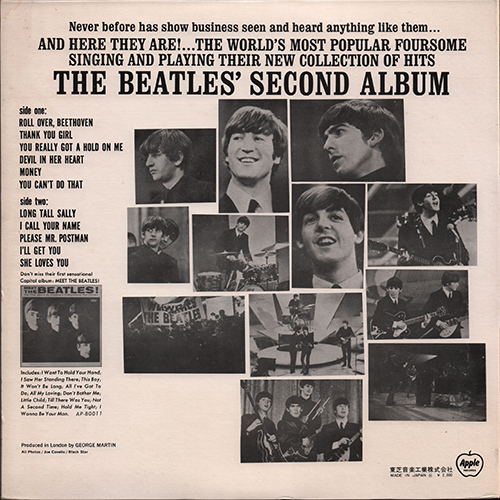 |
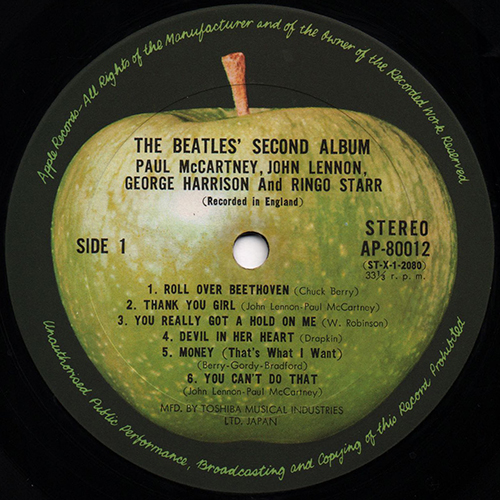 |
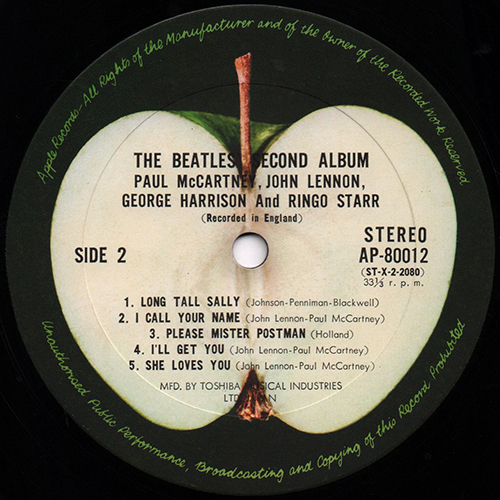 |
 |
|
| INSIDE --> Click! | INNER SLEEVE | ||||
| FRONT --> Click! | BACK --> Click! | With Apple custom black inner sleeve. | |||
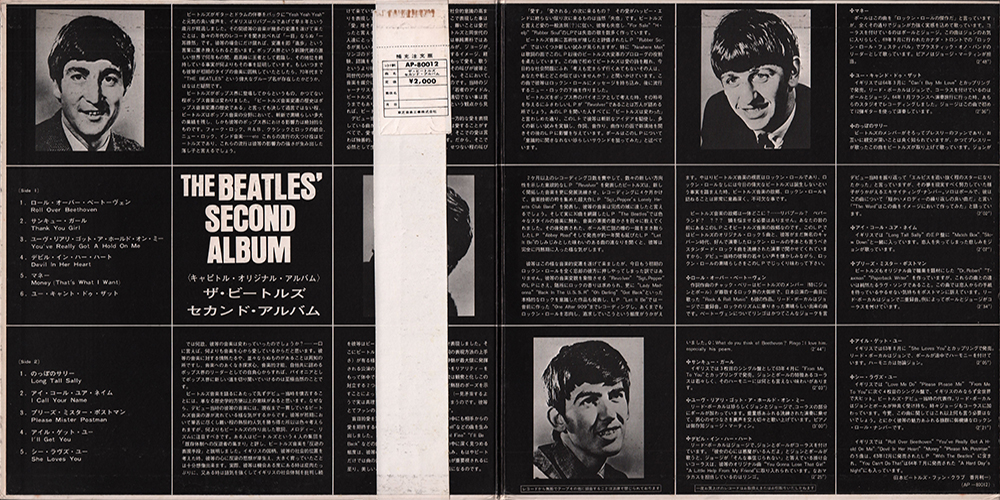 |
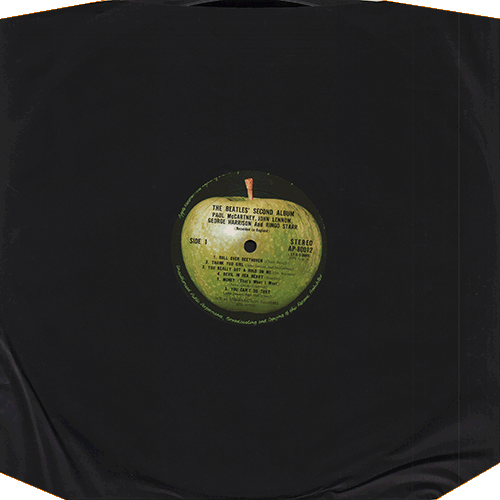 |
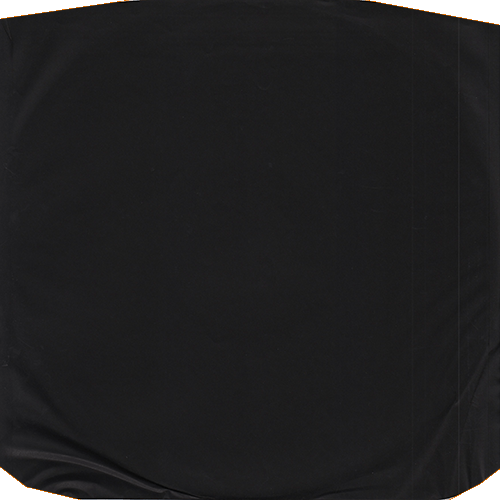 |
|||
| LYRIC SHEET (Slip
Sheet Type) |
|||||
| FRONT --> Click! | BACK --> Click! | LYRIC SHEET CLOSE UP | |||
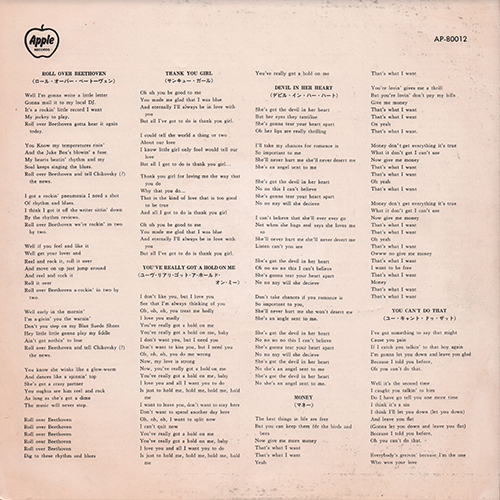 |
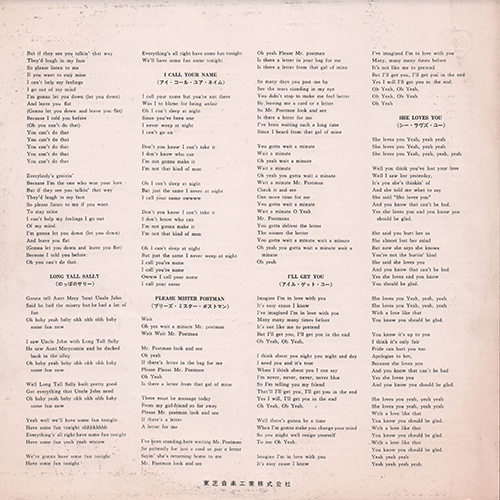 |
 |
 |
||
 |
Company name "Toshiba Musical Industries Ltd." was printed on the lyric sheet. | ||||
| FRONT AND BACK COVER CLOSE UP | |||||
 |
 |
 |
The Apple logomark was printed on the front and back
cover. "Toshiba Musical Industries Ltd." and "H ¥2,000" was printed at the bottomof the back cover. |
||
| BACK COVER CLOSE UP | |||||
 |
Produced in London by GEORGE
MARTIN All photos: Joe Covello / Black Star |
||||
| INSIDE CLOSE UP | |||||
 |
Liner notes: Toshikazu Katsuki
(1948-1999) is a leading Beatles expert in Japan. On October 21, 1976, he held his wedding ceremony at the Hilton Hotel, with Ringo Starr as a witness. |
||||
| Apple Gourd in White OBI CLOSE UP | |||||
| OBI: FRONT --> Click! | OBI: BACK --> Click! | ||||
 |
 |
 |
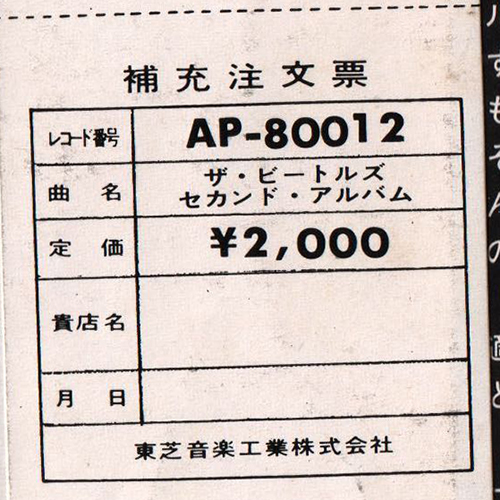 |
||
| Issued with a narrow Obi with a large round Apple logo at the top, has a white background. The word "STEREO" and Apple logo mark and catalog number "AP-80012" were printed on the front. 1st. pressing had a priced ¥2,000 on the obi strip. | Has a order sheet on the back side of the Obi. Catalog No, price "¥2,000" and "Toshiba Musical Industries Ltd."were printed at the order sheet. | ||||
| LABEL CLOSE UP | |||||
 |
 |
||||
| The phrase "Apple Records - All Rights of the Manufacturer and of the Owner of the Recorded work Reserved." was printed at the perimeter. | Sometimes
Toshiba had problems to press enough records to keep up with
the demand. To increase production they turned to other
companies (Gramophone, Sony etc.) to press up some copies of
a particular release. CBS Sony contract press: There is a ridge approximately 31mm out from the centre hole. Songs are from U.K. master tapes, different than USA pressings. |
||||
 |
 |
 |
The words "MFD. BY TOSHIBA MUSICAL INDUSTRIES LTD. JAPAN" was printed at the bottom of the label. | ||
| LABEL CLOSE UP | |||||
 |
 |
Dark green apple label. Slender font. |
|||
|
OTHER ITEM
|
|||||
| - | |||||
| RECORD LABEL | Dark Green Apple label Type-1 |
||||
| MIX | STEREO *excepted as noted |
||||
| MATRIX No. | SIDE 1 | ST-X-1-2080
1S 3 |
|||
| SIDE 2 | ST-X-2-2080
1S 2 |
||||
| PRESS MARK | F
S 7 |
||||
| VINYL COLOR | BLACK |
||||
| RECORD COMPANY'S NAME | SLEEVE | Toshiba
Ongaku
kogyo Kabusikigaisha |
|||
| LABEL | MFD. BY
TOSHIBA MUSICAL INDUSTRIES LTD. JAPAN |
||||
| SYMBOL/PRICE | H - ¥2,000 |
||||
| LYRIC SHEET STYLE | Slip Sheet Type |
||||
| COVER FORM | Gatefold type. Hard cover. |
||||
| INNER SLEEVE |
Apple custom black sleeve |
||||
| OBI |
"Gourd" in white Obi (a narrow Obi with a
large round Apple logo at the top) / with Order sheet |
||||
| COVER DESIGN/ PHOTO/ NOTES | All photos: Joe Covello / Black
Star |
||||
|
COMMENTS
|
Dark green Apple label
Type-1with black print. The Beatles' Second Album is the second Capitol Records album by the English rock band the Beatles. Second Album was a collection of material from various UK releases and recording sessions dating back to March 1963. Included were the five remaining tracks, all cover versions, from With the Beatles. Added to these were "Thank You Girl", the B-side to the single "From Me to You"; "She Loves You" and its B-side, "I'll Get You"; "You Can't Do That" (the B-side of "Can't Buy Me Love"), from the upcoming A Hard Day's Night UK soundtrack; and two new songs, "Long Tall Sally" and "I Call Your Name". Uses a copy of the US master, as identified by the matrix stamp. In Novemver 1968, that was the date when Apple Corp Ltd. of England and Toshiba came to an agreement on the manufacturing and distribution of the Beatles' records in Japan. As part of that agreement, Toshiba had to reissue on the Apple label all the records previously issued on the Odeon label. The sleeves also had to be altered to desplay the Apple logo. Futher still, all the Odeon catalog number prefixes were changed to ones with Apple prefixes. In most cases, only the prefixes were changed and the catalog numbers were left intanct. Odeon singles, EPs, and LPs with the OR or OP prefixes were changed to Apple singles, EPs, and LPs with the AR or AP prefixes, respectively. But Toshiba did not instantly implement all these changes and did not immediately withdraw all Odeon label records. In fact, the phasing out of the Odeon label products and the phasing in of the Apple label was a lengthy process taking several months at least. The very first record in Japan issued under the Toshiba/Apple contract and bearing the Apple label was "The Beatles double LP (the White Album)", released on 21th. January 1969. And unlike elsewhere in the world, the first single in Japan to bear the Apple label was not "Hey Jude / Revolution" but rather "Ob- La-Di, Ob-La-Da / While My Guitar Gently Weeps", released on 10th. March, 1969. And in the Apple label, there are two subtypes, TOSHIBA MUSIC and TOSHIBA EMI. Further more, the early copies of the APPLE-TOSHIBA MUSIC type have dark Apple on its label, though the late copies have light one. Black vinyl disc. Most if not all of the red vinyl OR and OP Odeon LPs were manufactured with an ingredient intended to prevent the buildup of static electricity on the disks. TOSHIBA's trademark for records manufactured with this ingredient is "Ever Clean", and special efforts were made to promote this feature. Sometimes Toshiba had problems to press enough records to keep up with the demand. To increase production they turned to other companies (Gramophone, Sony etc.) to press up some copies of a particular release, however, the majority of copies were pressed by Toshiba themselves. AP-80012 contract pressings: CBS SONY Contract Press PM=none There is a ridge approximately 31mm out from the centre hole (The diameter of the ridge is 69mm). The obi: Apple "Gourd" in white Obi 1st. pressing issued with a narrow Obi with a large round Apple logo at the top, has a white background. The word "STEREO" and Apple logo mark and catalog number "AP-80034" were printed on the front. 1st. pressing had a priced ¥2,000 on rear sleeve and obi strip. While most Japanese records feature local music, a lot of music fans there like foreign music, as well. The language barrier in Japan presented a problem – should foreign album covers be changed for Japanese albums? The solution was the obi, which means “belt” or “sash”. The obi is a strip of paper, usually about two inches wide, that wraps vertically around the album cover, containing information about the artist and album in Japanese. As these strips of paper were fragile and easily torn, they are often missing, especially since consumers in the 1950s and 1960s attached little significance to them. Finding Japanese records made prior to 1970 that still have the obi intact can be quite difficult, and for some albums, nearly impossible. The inclusion of the obi can dramatically affect the price of some Japanese records, sometimes increasing the price by a factor of ten. |
||||
